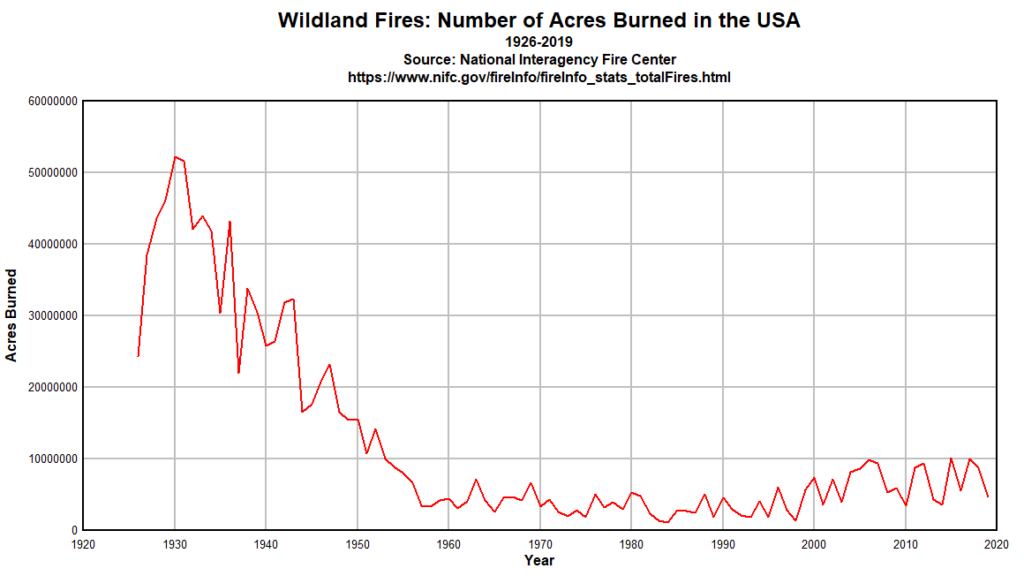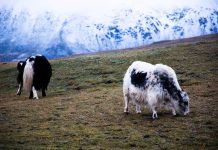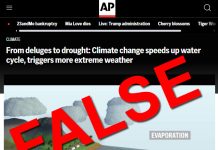An article by the Associated Press (AP) claims that wildfires are getting worse due to climate change, which is causing farm workers more exposure to wildfire smoke and potential harm to their health. This is false. Wildfires are not getting worse, so farmers and laborers cannot be more exposed to smoke or particulates for that reason.
In the AP article, “Wildfires are growing under climate change, and their smoke threatens farmworkers, study says,” the deception is clear and immediate. The study referred to in the title is a health survey about air quality monitoring in mandatory wildfire evacuation zones, and the abstract paragraph asserts that wildfires are getting worse due to climate change, but offers no evidence of this. The only explanation given for the claim is that wildfire intensity and frequency “are predicted to increase with global warming.” The study also claims that the 2020 California wildfire season was “unprecedented” –which is false, as Climate Realism explained at the time, here. Their baseless claim gave cover for the AP to write the following:
As climate change increases the frequency and intensity of wildfires around the world, a new study shows that farmworkers are paying a heavy price by being exposed to high levels of air pollution. And in Sonoma County, the focus of the work, researchers found that a program aimed at determining when it was safe to work during wildfires did not adequately protect farmworkers.
That is the first and last time climate change is mentioned in the entire article. Despite the climate change hook at the beginning, it actually has very little to do with climate change while the rest of the piece focuses on how farm workers are pressured to work in unsafe conditions and the kinds of occupational safety protocols that should be followed to reduce smoke inhalation when wildfires occur in regions with a lot of agriculture.
The study itself also seems to use climate change only as a hook, when the bulk of the research is actually about air quality monitoring during wildfire outbreaks in Sonoma County in particular, and then makes policy recommendations for employers of farm workers to provide hazard pay and post-exposure healthcare cost coverage.
In a classic case of failure to avail themselves of readily available evidence that counters their pet theory, the researchers conveniently ignore the historically quiet wildfire seasons that have occurred since the 2020 outlier, even though the reversal occurred well before the study’s July 2024 publication date. A Climate Realism post covering the multi-year mild wildfire seasons quoted one scientist who admitted that California has some of the most extreme inter-annual variability with temperature and precipitation, and that it is “normal to go from a record wet year to a record, or nearly record, dry year and that’s just the way it is.”
The number of acres burned by wildfires in the United States declined rapidly after their peak in the 1930s, and only since the 80s began to see a mild upward overall trend again. (See figure below)

But what is interesting is that the prevalence of drought, a major variable that affects wildfire spread, has not increased over that period. What has increased is the amount of available fuel because of forest mismanagement because of well-meaning but ultimately foolish environmental preservation philosophies, and increasing numbers of people living in naturally fire-prone areas.
At the global scale, wildfires and carbon dioxide emissions have a very poor correlation, when looking at the best available NASA satellite data. (See figure below)

Data from NASA and the European Space Agency both show a significant decline in wildfires during the recent period of modest warming, as discussed in Climate at a Glance: Global Wildfires. Also, as discussed in multiple Climate Realism posts, here, for example, even the Intergovernmental Panel on Climate Change finds no evidence for an increase in wildfire weather in recent decades or projects such an increase into the future.
If climate change isn’t causing worsening wildfire seasons, then it can’t increase the threat to farm workers from wildfire smoke – it’s that simple.
Farm workers not being evacuated despite mandatory evacuation orders during wildfires, which lead them to inhale dangerous amounts of smoke while working is not a climate issue. The AP and the study authors do a disservice to their cause by trying to force the connection. Perhaps they believe tying it to climate change will court some additional funding for their programs, and they might be right. However, by doing so, they are feeding into a miasma of misinformation surrounding wildfires and climate change and thereby doing a disservice to the pursuit of and public presentation and discussion of truth.


















